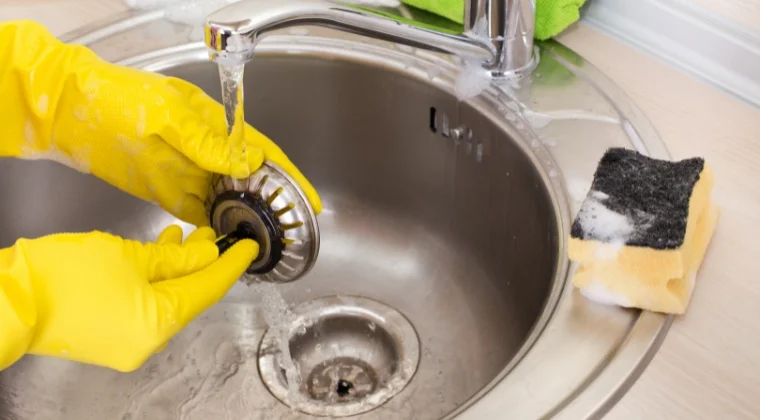
Best Way to Unclog Sink Drain
Dealing with a clogged sink drain can be a real headache. You might have tried some basic fixes, but sometimes they just don't cut it.
Luckily, there are more advanced methods that not only clear the clog but also help keep your drains running smoothly in the future. At Berkeley Plumbing Pros, our experience dealing with tough clogs gives us unique insights into effective strategies that work.
In this article, we'll explore several approaches that go beyond ordinary solutions, helping you tackle those stubborn sink drain clogs like a pro.
Key Takeaways
- Use a plunger or drain snake for minor to deep clogs.
- Remove excess water before unclogging to avoid spills.
- Consider natural solutions like baking soda and vinegar.
- Seek professional help for severe blockages.
- Prevent future clogs with periodic maintenance.
Tools Needed
To effectively unclog a sink drain, you'll need basic tools such as a plunger, a drain snake, and a bucket. These tools are vital for both DIY solutions and determining when it's time to seek professional help.
When facing a clogged sink, looking for temporary fixes is common, but it's important to contemplate long-term solutions to prevent future clogs.
The plunger is a versatile tool that can often resolve minor clogs by creating pressure to dislodge the blockage. It's handy for any household and relatively easy to use.
A drain snake, on the other hand, is more effective for deeper clogs that the plunger can't handle. It can reach further down the pipe to remove the blockage efficiently.
Additionally, having a bucket nearby is crucial to catch any excess water that may spill out during the unclogging process.
Remove Excess Water
Consider draining any excess water from the sink before attempting to unclog the drain to avoid potential spillage and mess. To start, check the water level in the sink. If it's high, you risk water overflowing as you work on unclogging the drain. Overflow prevention is vital to maintaining a clean workspace.
To remove excess water effectively, grab a small container or bucket to collect the water. Scoop out as much water as possible and dispose of it in a separate sink or toilet. This step won't only prevent potential spills but also make it easier to access the drain for unclogging.
Once you've removed most of the water, use a rag or sponge to soak up any remaining water in the sink. Wring out the excess water from the rag or sponge into the bucket. This final step ensures that the sink is dry enough for you to begin unclogging the drain without creating a watery mess.
Try a Plunger
To unclog your sink drain effectively, start by using a plunger with force to dislodge any obstructions. Make sure to check for blockages by plunging a few times and observing the flow of water.
This method can be a simple yet powerful way to clear minor clogs in your sink drain.
Plunge With Force
Begin by applying firm pressure to the plunger before plunging the sink drain to effectively clear any clogs.
To plunge with force, make sure you're using the right technique and form. Initially, ensure the plunger forms a tight seal around the drain opening. This seal is vital for creating the necessary pressure to dislodge the clog.
When plunging, maintain a straight posture to generate maximum force. Use quick and sharp plunges rather than slow and gentle ones. Push down firmly, then pull up rapidly to create a strong suction motion that helps break up the obstruction. Remember to plunge straight up and down to prevent splashing.
While plunging with force is effective, it's crucial to take safety precautions to avoid injuries. Wear gloves to protect your hands and make sure the area around the sink is clear of any obstacles. Don't apply excessive force that could damage the plumbing.
Check for Blockages
Start by checking for blockages in the sink drain by attempting to clear them with a plunger. Plunging can often dislodge clogs caused by debris buildup such as grease, food particles, or hair. Place the plunger over the drain opening, ensuring a tight seal, and push and pull vigorously to create suction that may dislodge the blockage.
If plunging doesn't resolve the issue, there are some DIY remedies you can try before seeking professional help. One common culprit of sink clogs is a mixture of grease and soap scum that accumulates over time. To prevent this, consider regularly pouring boiling water down the drain to dissolve any buildup.
Furthermore, using a hair catcher in the shower or bathroom sink can prevent hair from causing blockages.
If DIY methods fail to clear the blockage, it may be time to seek professional help. Plumbers have the expertise and tools to tackle stubborn clogs effectively, ensuring your sink drain flows freely once again.
Use a Drain Snake
Clear clogs effectively with a drain snake, a versatile tool used to break through blockages in sink drains. When faced with a stubborn clog that won't budge with traditional methods, a drain snake can be a game-changer. This tool is designed to navigate through pipes, hook onto debris, and pull it back out, restoring proper water flow in your sink.
If you don't have a drain snake on hand, there are some alternatives you can try. DIY solutions like using a wire hanger or a plastic drain stick may help dislodge minor clogs. However, for more challenging blockages, investing in a drain snake is the way to go.
While DIY methods can be effective, sometimes the clog may be too severe for these approaches. In such cases, it's advisable to seek professional help. A plumber can use specialized tools and techniques to tackle even the toughest blockages, ensuring your sink drains properly. Remember, knowing when to call in a professional can save you time and frustration in the long run.
Do you need affordable and reliable drain cleaning in berkeley?
Baking Soda and Vinegar
To tackle sink drain clogs, consider using a mixture of baking soda and vinegar as a natural and effective solution. This method is one of the most popular alternative methods for unclogging drains before seeking professional help.
One of the advantages of using baking soda and vinegar is its minimal environmental impact compared to harsh chemical drain cleaners.
- To utilize this method, start by pouring a pot of boiling water down the drain to loosen any grease or debris.
- Then, pour half a cup of baking soda followed by a mixture of one cup of vinegar and one cup of hot water.
- Cover the drain with a stopper to allow the fizzing action to work on the clog for about 10-15 minutes before flushing with hot water.
Hot Water Flush
For a crucial final step in unclogging your sink drain after using baking soda and vinegar, consider flushing it with a generous amount of hot water. Boiling water is highly effective in dislodging any remaining debris or blockages in the pipes. The heat from the water helps to break down grease, soap scum, and other substances that may be causing the clog.
To perform a hot water flush, simply boil a large pot of water on the stove or in a kettle. Once the water reaches a rolling boil, carefully pour it down the drain in a steady stream. Allow the hot water to work its way through the pipes for a few minutes to ensure it reaches the clog.
Commercial Drain Cleaner
When faced with a stubborn clog in your sink drain, commercial drain cleaners can be a powerful solution. These chemical drain cleaners are designed to break down and dissolve the organic matter causing the blockage.
Alternatively, you can consider natural drain uncloggers as a more eco-friendly option.
Natural Drain Uncloggers
Consider incorporating natural drain uncloggers, such as commercial drain cleaners made with eco-friendly ingredients, to tackle sink blockages in a more environmentally conscious manner. These DIY remedies and eco-friendly solutions offer effective ways to maintain your drains without harsh chemicals.
Household alternatives like enzyme-based cleaners utilize natural bacteria to break down organic matter, reducing clogs over time.
When opting for commercial drain cleaners, look for products labeled as biodegradable and non-toxic. These eco-friendly solutions are gentler on your pipes while still providing powerful clog removal.
Regular use of these maintenance tips can help prevent future blockages and keep your drains flowing smoothly. Remember to follow the instructions carefully, as improper use could lead to ineffective results.
Check the P-trap
To inspect the P-trap for any blockages, disconnect the trap by unscrewing the nuts securing it in place. The P-trap maintenance is vital in preventing clogs; however, common causes like grease buildup or foreign objects can still lead to blockages.
Here's how you can handle this task effectively:
- Carefully Remove the P-Trap: Use a wrench to loosen the nuts and carefully remove the P-trap from the sink drain. Be prepared for any water or debris that may come out when detaching the trap.
- Check for Blockages: Inspect the P-trap for any clogs or debris that may be causing the drainage issue. Use a wire brush or a small plumbing snake to dislodge any blockages.
- Clean the P-Trap: Thoroughly clean the P-trap with warm soapy water to remove any gunk or buildup that could lead to future clogs.
- Reassemble the P-Trap: Once cleaned, securely reattach the P-trap to the sink drain using the nuts. Test the sink to make sure proper drainage.
Prevent Future Clogs
Examining the P-trap for blockages is crucial; now, concentrate on preventing future clogs to maintain a clear sink drain.
Regular maintenance is vital to keeping your sink drain clog-free. One effective way to prevent clogs is by using a hair catcher in the shower and bathroom sink to trap hair and prevent it from going down the drain.
Moreover, avoid pouring grease, oils, or coffee grounds down the kitchen sink, as these can solidify and cause blockages over time.
Frequently Asked Questions
Can I Use Bleach to Unclog a Sink Drain?
Using bleach to unclog a sink drain can be effective but may harm pipes and the environment. Safe alternatives like baking soda and vinegar are gentler and eco-friendly. These methods can help clear blockages without causing damage.
Is It Safe to Mix Baking Soda and Vinegar?
When mixing baking soda and vinegar, safety precautions are essential. While safe for unclogging drains, avoid splashing and use in a well-ventilated area. For an alternative solution, consider using a drain snake for tougher clogs.
How Often Should I Clean the P-Trap?
Cleaning the P-trap is essential for preventing clogs. Regular maintenance helps avoid blockages and foul odors. Signs of buildup include slow draining and gurgling noises. Clean the P-trap every 3-6 months to keep your sink running smoothly.
Can I Prevent Future Clogs With a Hair Catcher?
To prevent future clogs effectively, using a hair catcher offers numerous benefits. It traps hair and debris, preventing them from going down the drain. Regularly cleaning the catcher stops buildup, ensuring smooth drainage and minimizing potential blockages.
Final Thoughts
Following these easy steps will help you clear up that clogged sink drain and keep it flowing smoothly. Make sure to use the correct tools, like a plunger or a drain snake.
It's also important to be careful if you decide to use chemical cleaners. Keeping up with regular maintenance and taking care of any problems right away will help your sink drains stay open and work well.
If you're not up for the task, at Berkeley Plumbing Pros, we're ready to help. You can call us at (877) 959-6069, and we serve Berkeley and the nearby areas.

